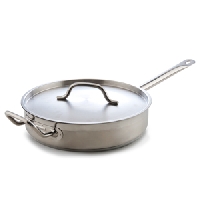
Cooking with a skillet that is the right size and shape makes all the difference
Does the kind of skillet you cook in make a difference and have any bearing on the outcome? (Yes, that is the ghost of Julia Child grabbing her heart and toppling over.) Of course it does. Different foods require different cooking vessels for best results.
A skillet is a frying pan with low, flared sides. The shape promotes evaporation. That’s why skillets are ideal for browning, searing and reducing sauce.
Non-stick
Non-stick pans are nice because food doesn’t stick and they are easy to clean. Less oil is required. Food such as eggs do not fall apart. Non-stick pans require non-stick utensils, such as a heat-proof spatula and a wooden spoon because metal utensils scratch and mar the non-stick surface.
Avoid heating an empty-non-stick pan over high heat. Doing so can bread down the coating causing potentially lethal fumes to be released.
~
Eco friendly or green cookware is on the market. It boasts a non-stick coating and is an option to the typical non-stick cookware.
Cast-iron skillet
With proper maintenance, this skillet lasts forever. It is a superb conductor of heat and heats uniformly. There are no hot spots. It doesn’t cost much and when ‘well-seasoned’ is stick-opposing, not requiring additional oil. When seasoning or ‘curing’ a pan of this nature, it will not rust and food doesn’t stick. Seasoning means filling the voids and pores in the pan with grease, which is then cooked. Do this by rubbing a slight coat of oil into the pan and then rub it off, using a paper towel. This creates a non-stick surface that is smooth.
Cast-iron is versatile, doesn’t warp and is easy to clean. Food slides across the surface as though it were a non-stick Teflon pan. Cast iron can be used on the stove top or in the oven. Food cooked in cast iron tastes particularly good.
Before using cast-iron, pre-heat the pan. Water droplets hiss when dropped into the pan. If the water immediately vanishes, the pan is too hot. if the water bubbles but doesn’t hiss the pan isn’t hot enough.
When purchasing this type of pan know that it comes covered with a protective coating, which you must remove. Scrub the pan using a steel wool scouring pad, hot water and soap.
Ask your grandmother or great-grandmother about cast-iron. Odds are she will give it a resounding thumb’s up. A 10-inch cast-iron skillet is generally big enough but if you cook for an army get a 12-inch.
Non-reactive
Non-reactive pans should be used when cooking acidic foods. Stainless steel, glass or enamel-coated cookware is non-reactive. Cast-iron and aluminum are reactive and cause acidic food to taste funny.
Stainless steel
Many cooks like stainless steel because it’s adaptable, hard-wearing and robust. Some consider it the workhorse of the kitchen.
What about aluminum?
High levels of aluminum intake have been associated with Alzheimer’s disease; however, recent studies show the likelihood of this is slight.
- Handles should be made of stainless steel because they won’t get hot.
- Some skillets come equipped with a helper handle located on the opposite side from the long handle. This is very helpful and allows the cook to pick up the pan with both hands, which is safer.
- Ask the cooks in your family which they recommend before you make the purchase.

